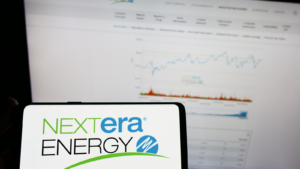While green energy initiatives represent one of the most relevant segments of the modern economy, harvesting the power potentiality is especially critical. That’s because traditional platforms of sustainable energy are intermittent: the sun only shines for so many hours and the wind doesn’t blow perpetually. Because of this reality, clean energy storage stocks may see greater prominence in the years ahead.
According to Grand View Research, the global renewable energy market reached a valuation of $1.21 trillion last year. Between 2024 to 2030, experts believe the sector could expand at a compound annual growth rate of 17.2%. At the culmination point, the green ecosystem may generate revenue of $3.6 trillion. Because the intermittent nature of certain platforms won’t ever change, storage solutions may ride coattails.
In other words, the clean energy story is really a story about energy harvesting. The two intertwine perpetually. With that, below are clean energy storage stocks to consider.
NextEra Energy (NEE)

As one of the top utilities in the renewable energy space, NextEra Energy (NYSE:NEE) makes for an obvious but ideal play among clean energy stocks. Now, it must be said that NEE stock itself trades for a hot premium. Right now, shares trade hands at 6.15X trailing-year sales. In contrast, the sector median stands at 2.69X.
Still, that doesn’t necessarily bother me. Right now, NEE stock carries a consensus moderate buy view. To be fair, the average price target sits at $79.63, which implies less than 3% upside potential. However, the high-side target calls for $95. That’s a more recent target issued by Wells Fargo, implying over 22% upside. It also seems more realistic given the present ideological backdrop.
Further, analysts are modeling fiscal 2024 earnings per share to hit $3.40. If so, that would imply expansion of 7.26% from last year’s print of $3.17. On the top line, revenue could land at $27.53 billion, which is a dip from last year’s print of $28.11 billion. However, the most optimistic view calls for $30.59 billion.
Overall, NEE has the relevance and the qualities to rank among the clean energy storage stocks.
Enphase Energy (ENPH)

A solar energy specialist, Enphase Energy (NASDAQ:ENPH) focuses on solar photovoltaic solutions. It’s one of the most popular ideas for clean energy storage stocks as the company brings to the table mechanisms for harvesting solar power. Right now, ENPH stock trades at 10.07X trailing-year revenue. Admittedly, that’s a hot premium. Still, there’s potential to be extracted.
Overall, analysts rate shares a consensus moderate buy. The average price target stands at $125.37, implying over 21% upside potential. Further, the most optimistic view calls for a price per share of $166. Fundamentally, if monetary policy eases up, demand for Enphase products could reignite, possibly sending ENPH stock higher.
At the moment, analysts are modeling for a significant erosion in sales to $1.4 billion in fiscal 2024. Last year, the metric stood at $2.29 billion. However, a gradual recovery could take place, starting in 2025. Consensus sales estimates call for $2.03 billion, with a high-side estimate of $2.33 billion. Earnings could also start recovering a year-and-a-half from now.
It’s a higher-risk idea compared to NextEra Energy. Still ENPH should be on your radar of clean energy storage stocks to consider.
Fluence Energy (FLNC)
Another player in the utilizes field, Fluence Energy (NASDAQ:FLNC) offers energy storage products and solutions. Notably, it leverages artificial intelligence to provide effective services for the renewable energy and storage application sectors. Naturally, FLNC makes for a compelling candidate among clean energy storage stocks.
Still, nothing in the market is for free. While Fluence may be attractive, it’s also wildly risky. Since the start of the year, FLNC stock fell almost 42%. In the past 52 weeks, it’s down nearly 50%. However, if a silver lining exists in all this red ink, it’s that shares trade hands at 0.76X sales. That’s much lower than the renewable utilities’ average ratio of 2.69.
Even better, we’re not talking about a value trap – not if analysts’ projections hold true. By year’s end, revenue could hit $2.91 billion. If so, that would imply a growth rate of 31.2% from last year’s tally of $2.22 billion. In fiscal 2025, sales could rise to $3.92 billion, with a high-side view of $4.12 billion.
Best of all, analysts rate FLNC stock a consensus strong buy with a $30.21 price target. That implies 118% upside potential.
On the date of publication, Josh Enomoto did not have (either directly or indirectly) any positions in the securities mentioned in this article. The opinions expressed in this article are those of the writer, subject to the InvestorPlace.com Publishing Guidelines.
On the date of publication, the responsible editor did not have (either directly or indirectly) any positions in the securities mentioned in this article.
